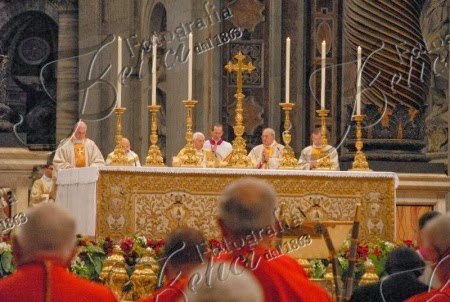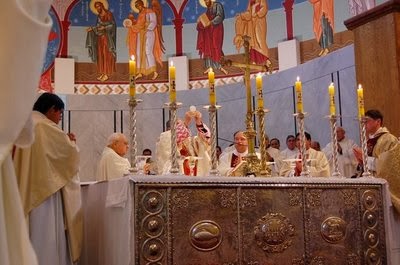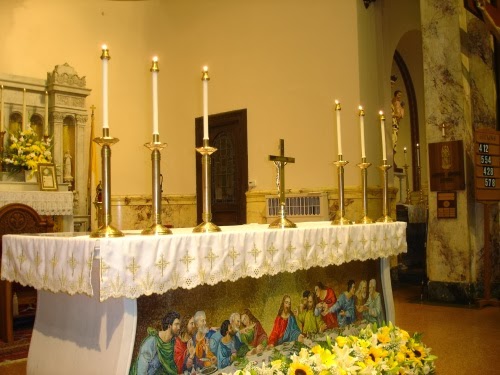Pope Benedict XVI was well known for introducing, in the context of the celebration of the modern Roman Rite, a more traditional arrangement of the candles and crucifix upon the altar—namely, the “big six” with the cross in the middle (or, at times, seven candles—a privilege of bishops). The reason he decisively returned to this arrangement is quite simple: it greatly helps the celebrant and the faithful alike to perceive and thus to reverence the greatness of the altar of sacrifice, and, in that connection, to turn their interior gaze to Jesus Christ, who stands at the very center of the liturgical action. It is, in short, a re-centering of the community upon the Alpha and Omega, the One who offers Himself up for our salvation and makes us participants in His offering. The priest is no longer the center of attention: he is merely the “animated instrument” (as St. Thomas would say) of the Eternal High Priest. He steps back, as did St. John the Baptist, saying: “He must increase, I must decrease.”
Shifting the center of gravity from a minister to the solid and silent sacred altar and the Lord it represents and bears upon itself is a long-overdue antidote for the dreadful spirit of horizontal community-fixation and the cult of personality that entered into the Catholic Church with the abandonment of worship eastward (ad orientem). Wherever the priest and people worship facing eastwards, the Benedictine arrangement is not really necessary, although it remains beautiful and fitting. But wherever the priest is still following the novel custom of facing the people (novel because it breaks with almost 2,000 years of Christian practice), something like the Benedictine arrangement is absolutely necessary in order to preserve the meaning of the eastward orientation.
In chapter 3 of his masterpiece The Spirit of the Liturgy, Ratzinger make this point with his customary eloquence:
Given this luminous teaching and example, it is worth pointing out that Pope Francis said much the same thing when addressing an assembly of Jesuits in Rome on July 31, 2013. Although he was not speaking specifically about the sacred liturgy, what he said is an echo and elaboration of Ratzinger’s theologia crucis:
Celebrants: Assuming the best intentions on your part, have you considered the fact that in the absence of the Benedictine altar arrangement, it can look, in practice, as if you're meant to be the center of attention? Should it not be Christ who is manifestly the center of the Mass, so that all eyes are fixed on the unique sign of God’s ineffable love for us, the Cross? Do our souls, with humble adoration, focus on the altar, whence the streams of His plentiful redemption are poured forth? For this, indeed, is what is objectively going on at any validly offered Mass, but we foolish humans can find a thousand and one ways to hide, cover, distort, or otherwise detract from that reality. Instead, we should do everything in our power to make the liturgy look and feel like what it really is.
If you have not yet adopted the Benedictine arrangement, what are you waiting for? How about the solemn liturgies coming up at Christmas? There is no better time to take a step like this than the holiest of our holy days, when Christ as Alpha and Omega should break through all the more into our minds and hearts.
If, on the other hand, you have already adopted the Benedictine arrangement in your community, think carefully about the next step that might be taken to lead the faithful into a still more profound participation in the awesomeness of the immortal and life-giving mysteries.
(For inspiration, below are photos of very different sanctuaries and altars that demonstrate the Benedictine arrangement. It will be noted that in some cases the crucifix is too small in proportion to the candles and that a larger crucifix would serve better symbolically and aesthetically. Please note, also, that a placement of seven candles is for episcopal liturgies, since the seventh candle is a privilege of the bishop.)
Shifting the center of gravity from a minister to the solid and silent sacred altar and the Lord it represents and bears upon itself is a long-overdue antidote for the dreadful spirit of horizontal community-fixation and the cult of personality that entered into the Catholic Church with the abandonment of worship eastward (ad orientem). Wherever the priest and people worship facing eastwards, the Benedictine arrangement is not really necessary, although it remains beautiful and fitting. But wherever the priest is still following the novel custom of facing the people (novel because it breaks with almost 2,000 years of Christian practice), something like the Benedictine arrangement is absolutely necessary in order to preserve the meaning of the eastward orientation.
In chapter 3 of his masterpiece The Spirit of the Liturgy, Ratzinger make this point with his customary eloquence:
The turning of the priest toward the people has turned the community into a self-enclosed circle. In its outward form, it no longer opens out on what lies ahead and above, but is locked into itself. The common turning toward the East was not a “celebration toward the wall”; it did not mean that the priest “had his back to the people”: the priest himself was not regarded as so important. For just as the congregation in the synagogue looked together toward Jerusalem, so in the Christian Liturgy the congregation looked together “toward the Lord.”And there is the passage where Ratzinger says that even if, at this juncture, restoring the correct orientation of worship may not be possible in every place, nevertheless it is high time to reestablish, in an obvious visible way, the primacy and centrality of Jesus Christ in the celebration of His Holy Sacrifice, and that the easiest and simplest way to do this is to put the altar cross right back where it belongs, in the very front and center of everything. Those who are familiar with Ratzinger will recognize the themes: the Church is called upon not to preach herself, to exhibit herself and offer prayers from and to herself, but rather to preach Christ Crucified, to point always to Him, to make clear the path to Him from whom all prayer begins and in whom all prayer culminates.
[A] common turning to the East during the Eucharistic Prayer remains essential. This is not a case of accidentals, but of essentials. Looking at the priest has no importance. What matters is looking together at the Lord.
Moving the altar cross to the side to give an uninterrupted view of the priest is something I regard as one of the truly absurd phenomena of recent decades. Is the cross disruptive during Mass? Is the priest more important than Our Lord?
Given this luminous teaching and example, it is worth pointing out that Pope Francis said much the same thing when addressing an assembly of Jesuits in Rome on July 31, 2013. Although he was not speaking specifically about the sacred liturgy, what he said is an echo and elaboration of Ratzinger’s theologia crucis:
The emblem of us Jesuits is a monogram, the acronym of “Jesus, the Saviour of Mankind” (IHS). Every one of you can tell me: we know that very well! But this crest continually reminds us of a reality that we must never forget: the centrality of Christ for each one of us and for the whole Company, the Company that Saint Ignatius wanted to name “of Jesus” to indicate the point of reference. Moreover, even at the beginning of the Spiritual Exercises he places our Lord Jesus Christ, our Creator and Saviour (Spiritual Exercises, 6) in front of us. And this leads all of us Jesuits, and the whole Company, to be “decentered,” to have “Christ more and more” before us, the “Deus semper maior”, the “intimior intimo meo”, that leads us continually outside ourselves, that brings us to a certain kenosis, a “going beyond our own loves, desires, and interests” (Sp. Ex.,189). Isn’t it obvious, the question for us? For all of us? “Is Christ the center of my life? Do I really put Christ at the center of my life?” Because there is always the temptation to want to put ourselves in the center.That is the fundamental question: Do we really put Christ at the center of the Mass? Or do we somehow manage to put ourselves there, where He alone should be?
Celebrants: Assuming the best intentions on your part, have you considered the fact that in the absence of the Benedictine altar arrangement, it can look, in practice, as if you're meant to be the center of attention? Should it not be Christ who is manifestly the center of the Mass, so that all eyes are fixed on the unique sign of God’s ineffable love for us, the Cross? Do our souls, with humble adoration, focus on the altar, whence the streams of His plentiful redemption are poured forth? For this, indeed, is what is objectively going on at any validly offered Mass, but we foolish humans can find a thousand and one ways to hide, cover, distort, or otherwise detract from that reality. Instead, we should do everything in our power to make the liturgy look and feel like what it really is.
If you have not yet adopted the Benedictine arrangement, what are you waiting for? How about the solemn liturgies coming up at Christmas? There is no better time to take a step like this than the holiest of our holy days, when Christ as Alpha and Omega should break through all the more into our minds and hearts.
If, on the other hand, you have already adopted the Benedictine arrangement in your community, think carefully about the next step that might be taken to lead the faithful into a still more profound participation in the awesomeness of the immortal and life-giving mysteries.
(For inspiration, below are photos of very different sanctuaries and altars that demonstrate the Benedictine arrangement. It will be noted that in some cases the crucifix is too small in proportion to the candles and that a larger crucifix would serve better symbolically and aesthetically. Please note, also, that a placement of seven candles is for episcopal liturgies, since the seventh candle is a privilege of the bishop.)














